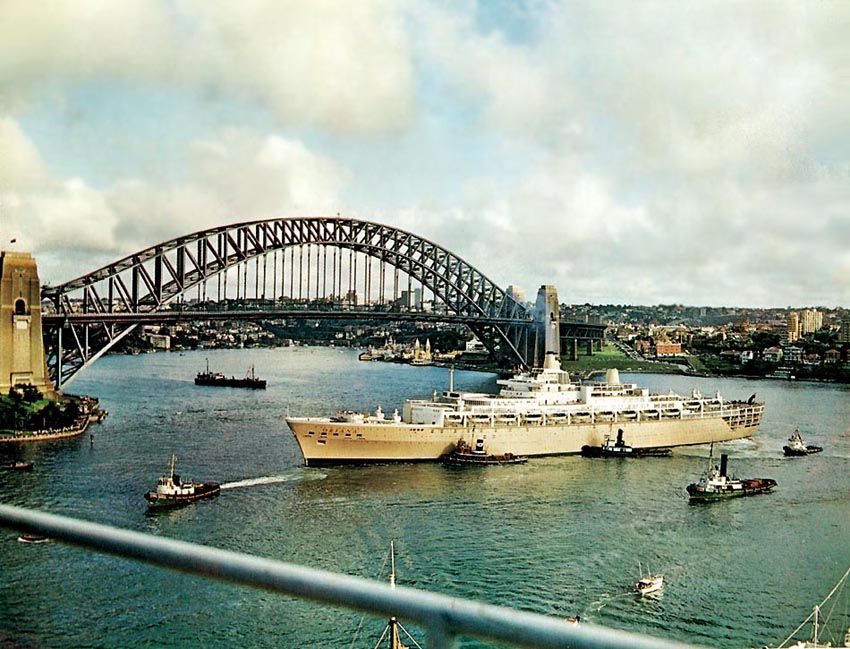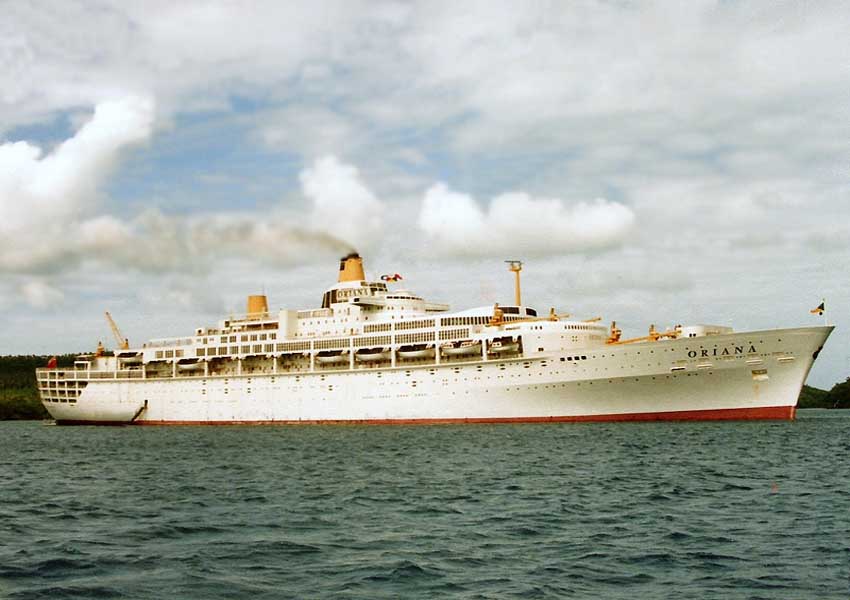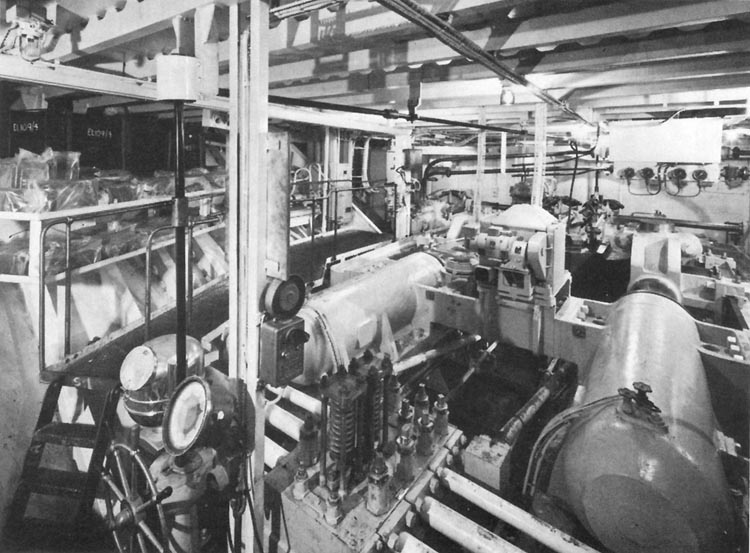The very Last Orient Liner built, SS Oriana (1960 to 1986) she was
then sold to
Please Note: Firefox and some other search engines may not suitable
Please use Google Chrome for this page to load perfectly!
Click the logo above to reach the ssMaritime FrontPage for News Updates & “Ship of the Month”
With
Maritime
Historian, Author and Lecturer & Cruise‘n’Ship Reviewer

Page 5
Introduction:
When SS Oriana was completed in 1960 she was
the largest passenger liner ever built in
Upon the Oriana’s completion it was said that she cost around £14,000,000 sterling and as she proved over the many years, that she was worth every single penny of it and more for that matter!

The laying of the first section of the keel, #1061, which was a good 24½ tons of steel.
It was decorated with the Union jack, the Orient Line House Flag as well as a silhouette of the ship
Photograph by Vickers Armstrong Ltd
She was especially constructed for the
Southampton to Australia service, sailing via the Suez Canal, returning via New
Zealand, the Pacific Ocean, Canada, the

The Oriana is seen here during her
Speed Trials and is doing her manoeuvre of a fast turn to Starboard
SS Oriana departed on her maiden voyage from
Southampton on Saturday December 3, 1960, arriving in

On this very special page, we will go far deeper into finer details of the last ever Orient Liner built, and as you will soon discover. I am sure that you will find something new and interesting in within the specialisations and the facts below! The truth is some of it has never been published, as most just publish the basics, length, breath, machinery and other basics, etc. But you will find that details on her will go much further. Ship lovers Enjoy!
Please Note: The details provided relate to the time SS
Oriana was completed and delivered to Orient Line in 1960.
The
Specifications and facts on this page were compiled by Mr. Morris and I have
been given special permission to use not just all the special and many never
seen photographs from His personal and private collection and now his estate,
but also 99.5% of you will read below!
Specifications & Facts:
· Length: 804ft - 245.1m.
· Breadth: 97ft - 30.48m.
·
Normal loaded Draught (designed): 31.6ft - 9.63m.
· Depth (moulded) to Strength
· Deck (B Deck): 68.9ft - 21m.
· Max Loaded Draught: 32ft - 9.75m.
· Max Loaded Displacement: 39,020 tons.
· Gross Tonnage: 41,923 tons.
· Passengers: 688 First Class.
· “ 1,496 Tourist Class.
· Crew: 899.
· Total Complement: 3,083.
· Service Shaft Horse Power: 65,000.
· Corresponding RPM of Propellers: 147.
· Max Shaft Horsr Power: 80,000.
· Corresponding RPM of Propellers: 157.5.
· Service Speed: 27.5 knots.
· Trial Speed at 80,000 S.H.P.: 30.64 knots.
· Contract for Ship Placed: May 12, 1954.
· Keel Laid Down: September 18, 1957.
· Launched by Princess Alexandra: November 3, 1959.
· Delivered to Orient Line: November 16, 1960.
· Maiden Voyage: December 3, 1960.
·
General
Cargo: 150,542 cubic ft, (bale).
· Insulated Cargo: 53,520 cubic ft.
· Insulated Stores: 30,051 cubic ft.
· Bulk Stores: 36,305 cubic ft.
· Mail and Baggage Rooms: 32,846 cubic ft.
· Sundry Store Rooms: 60,664 cubic ft.
· Oil Fuel: 6,852 tons.
· Fresh Water (Domestic): 2,356 tons.
· Frest Water (Engineer’s Feed water): 593 tons.
· Water Ballast: 2,005 tons.
· Weight of Steel in Ship: 13,650 tons.
· Weight of Aluminium in Ship: 1,040 tons.
· Weight of Ship when Launched: 15,250 tons.
· Weight of Main machinery: 3,921 tons.
· Length of Piping in Ship: 50 miles.
· Length of Electric Cables & Wiring: 350 miles.
· Length of Trunking for Ventilation …
· and Air-Conditioning in Ship: 13 miles.
· Area of Aluminium Alloy Decks …
· and Bulkheads in Ship: ?/? Million square ft.
· Length of Aluminium Alloy …
· Extrusions in Ship: 20 miles.
· Length of Aluminium Alloy …
· Welding Wire used in Ship: 600 miles.
· Asbestos Boards for …
· Fire-resistant purposes: 165,000 square ft.
· Lifts for First Class Passengers: 5.
· Lifts for Tourist Class Passengers: 2.
· Air-Conditioning Cooling Capacity: 22,000,000 B-Th-U per hr.
· Air-Conditioning & Refrigeration
· Motors: 30 in number totalling 1,100 HP.
· Fans for Air-Conditioning: 130 - Totalling 650 HP.
· Lift from Engineers Accommodation
· To Machinery Spaces: 1.
· Other Lifts: 5.
· Electric Cranes of Capacity
·
to lift 5 tons each: 8.
Other Interesting Details:
The SS Oriana considering she was designed in
1953, was an ultra modern passenger liner for her time, and she was certainly far
ahead for her day, when she made her maiden voyage, and she was still one of
the most modern, stylish and amazing cruise ships operating in the
1980’s! The truth is that her unusual design and her brilliant interiors
never dated and with a brilliant crew she remained one of the most popular
cruise ships, especially when she was based in

SS Oriana now an Australian based Cruise Ship, is seen at anchor during a Pacific Cruise
Although I have provided a mass of
Specifications above, there is a great deal, which I trust that you will find
interesting. I should tell you at this stage, that I have all this information
due to the wonderful Naval Architect and one of the main Designers of the
Oriana, the amazing man, the late Mr. Charles F. Morris. In fact this
entire feature “The Birth of a Liner”
is thanks to his dear wife Mrs. Pauline Wakefield I was also presented with a special edition of Mr. Morris’ book
“Origins, Orient and Oriana”, which is a great Classic, and if you
love the SS Oriana you should try and obtain a copy for it is the best read
ever!
Now we have
had a short break from all those specs’ and info, let us get back to even
more, but what we will now discover will be in a different format, and cover a
wide range of details. Enjoy.

Here we see the electro-hydromatic steering gear
· Oriana had Electro-Hydraulic Steering Gear fitted.
· One Set of Stabilizers with fins, each having 120 sq.ft.
·
Sideway Manoeuvring Units
(Thrusters), two forward and two aft, each driven by electric motor, each of
550 BHP and each remotely controlled from the
· Baggage Handling Equipment, two forward and two aft, comprised overboard mechanical conveyors from ship to shore or visa-versa and after installation a long conveyor on the centre-line of the ship carrying baggage into or out of the Main Passenger Baggage Rooms.
·
Also fitted in the After
Baggage Rooms were two baggage elevators to convey baggage vertically within
the ship.
· A 500-line manual Telephone Exchange was fitted for First Class Cabins and the Pantry.
· An Automatic Telephone Exchange of 120 lines was installed for staff communications.
·
About 125 electric clocks were
fitted throughout the ship controlled by a Master Clock on the
· About 2,000 electric sockets and 10,000 lighting fittings were fitted in cabins.
· About 500 electric sockets and 5,000 lighting fittings were fitted in Public Rooms and Entrances.
· Evaporators to produce 650 tons of Fresh Water each day.
· There were fifteen decks and flats in the ship.
·
Epoxy-type paint was used on
the
· The steel or alloy decks were levelled with latex underlay before the wood deck was laid.
·
The teak wood Decks were only
1½ inches thick secured by special welded screws and nuts to reduce weight and
cost

Here we see the special screws & nuts topped by a dowel to secure the thin teak planks
· Soft-plastic decorative coverings were used on the walls of all First Class, Tourist Class and Crew Cabins. This was done to enable colour schemes to be changed from time to time as the ship aged, and for work to be done easily and inexpensively.
· About 110,600 square yards of carpet, comprising 80 miles of woollen yarn were used in the ship; there were 15 different designs of carpet and the approximate total weight of the finished carpet was 18 tons.
·
Amongst the systems fitted in
the ship were the following:
· Bilge and Ballast Piping.
· Scuppers and Dischargers.
· Cold, Hot and Iced Water Piping to cabins and pantries.
· Cold Salt Water Pipes.
· Air and Overflow Pipes.
· Steam Heating to Oil Fuel Tanks.
· Sprinkler System.
· Fresh Water Filling, Gas Smothering and Fire Detecting System.
· Levelling Pipes.
· Re-heat Piping for Air-conditioning.
· Air-conditioning and Ventilation Trunking.
· Natural Ventilation Trunking.
· Distant-reading Depth Gauges.
· Hydraulic System for Watertight Doors.
· Fresh Water Tank Pneumercator Systems.
· Steering Gear Telemotor Piping.
For all those who have sailed on the Oriana, or other Classic Liners, or eve today’s cruise ships, will realise that large passengers ships are comparable wit a small town, but in today’s standards with those huge 100,000 ton (and more) monsters it will be even like a large town! The only difference between a land based town and the ship is that it moves from place to place over the seas of the world, whilst the ships inhabitants will happily enjoy their surroundings, food, drink and service which is usually superior than normally given ashore.
The total number of persons on any Oriana voyage would be around 3,000 or more, thus this caused intense activity within the food-preparation spaces almost all day long. At least 20,000 hot meal courses were provided each and every day, whilst the Oriana was in commission. And then there was the Bakery and the Confectioner’s Shop who provided the loaves of bread and the crispy rolls, as well as a wide variety of cakes, all this was required by the thousands each day. Fresh milk and cream was brought aboard the ship at the ports visited, and to ensure that milk was always available a Mechanical ‘cow’ was fitted in the ship’s dairy, which was commonly said to be milked with a spanner!
There were many rooms, normally unseen by passengers, on the galley deck and the deck below it where activities went on to back up the cooking requirements of the ship, there was the butchers shop, fish and poultry rooms, vegetable preparing space, cold dish and salads service, and the essential plate, dish, cutlery and pan cleaning room, still rooms and cruet rooms and other spaces for innumerable jobs to be done connected with the provision of food for passengers and crew. The senior staff responsible for the running of the catering department of a large passenger ship was made up of highly trained people who had experience ashore in the best hotels in London and other cities of the world, and service and food and drink provided was at its best, equal at least to be found ashore.
Tableware used in First Class Restaurant and the Silver Grill was called Queens Ware, made by Josiah Wedgewood and Sons LTD., using decoration design by Professor Robert Goodden of the Royal College of Art. The design of cutlery was ‘ergonomic’ (i.e., of a shape suited to the palm of a human hand), designed by Robert Welch in stainless steel and made by Mappen and Webb. 65,200 pieces were required for the Oriana, amongst which were 14,000 table forks, 12,000 tea spoons, 10,000 table knives and fish knives, 1,000 jam spoons, 800 butter knives and 400 pickle forks, and then more.
To clean all the dishes there were three dishwashing machines in the galleys and pantries, each was 15 feet long. In one non-stop automatic transit through the machines the articles passing through would be scraped, washed and rinsed, and finally rinsed again to a high standard of hygiene. All the galley staff had to do was load the stainless steel conveyor rack at one end of the washing machine, and remove the cleaned and dried items at the other end. Four smaller spray-type dish-washing machines were also fitted on the ship.
Provision Rooms and Cold Chambers of the Ship were fully insulated with Polyurethane, a rigid foam weighing between 2 and 3 lbs, per cubic foot.
In Conclusion:
If you have reached and read this page this far you must be either a person who is a devoted past SS Oriana Passenger, an ex Crew member, or a genuine Classic Ship lover. It is true, this page contains a great deal of detail, as well as her specifications, but considering the SS Oriana was the last ship ever to be constructed for the “Orient Steam Navigation Company” or the “Orient Line”, which makes her a very special Passenger Liner and later a fine Cruise Ship indeed! The Oriana was a one of a kind ship as she stood out in a crowd of ships with her amidships towering Bridge with her funnel set slight back even further higher topping this fine lady, lovingly known as “The Queen of the Sea”.

Here we see the first photographic
postcard of the SS Oriana released by the Orient Line
***********************************
SS Oriana - Main Index:
PART ONE …
Designing & Building the Oriana - ONLY available to ssmaritime.com:
Images from the naval architect & designer of the SS Oriana:
Page 1: The building of SS Oriana
Page 2: The launching and fitting out of SS Oriana
Page 3: Sea trials and Oriana’s maiden voyage
Page 4: Deck
Plan, Rare Photographs and other Images
PART TWO …
Oriana’s General History Pages:
Page 1: History and Images of the Oriana
Page 2: Oriana Postcards issued in 1960
Page 3: Oriana Photo Album - Page 1
Page 4: Oriana Photo Album - Page 2
Page 5: Oriana “Lady of the Sea” by Neil Whitmore
Page 6: The Paul Oliver & Colin Pursehouse Collection
Page 6b: Paul Oliver Story
Page 7: Dalian - See the sad photographs of SS Oriana damaged during a storm
Page 7b: Oriana at Zhangiagang shipyard in China - Taken 29 July
& 9 September 2005, the demolition of a liner
Return to Part Two / Page One for SS Oriana’s … Overall History with many
Photographs
***********************************
This is recommended reading!
“Orient Line – A Fleet History”
Is available for £23.50 plus p&p from “Ships in Focus”
email: sales@shipsinfocus.co.uk
***********************************
Also Visit our Features on the following Orient Lines/P&O Ships
Orient Lines: RMS Orcades - SS Oronsay - SS Oriana - RMS Orion
P&O: RMS
Strathaird - SS
Iberia - SS
Canberra
********************************
Use the Back button on your browser or Close the
Page to return to the previous page
or go to our MAIN INDEX
Where you will discover over 1,358 Classic Liners & the 1914 built MV Doulos Feature
Photographs on ssmaritime.com, & .net and associate sites are: 1. By the author. 2. From the author’s private collection. 3. Or as provided by Shipping Companies and their Publicity Companies as well as by private photographers or collectors. Credit is given to all contributors whenever possible.
ssMaritime is owned and © Copyright -
